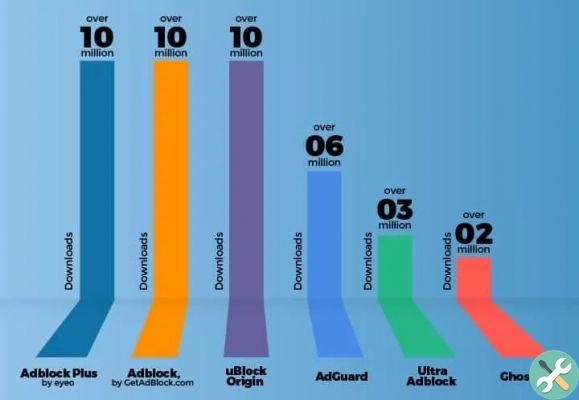This article is a continuation of How Ad Blockers Work (Part 1)
Many ads may be inappropriate
When using an advertising center, there is a chance that inappropriate advertisements will escape and appear on different websites. Ad placements are not programmed to filter ads before they appear on the website, so there is a possibility that classified ads appear on the website.
For example, ads containing gender or religion may appear on websites that target children. Another problem is that an announcement related to these sensitive topics may appear on the screen while you work or share your screen in an online meeting. This isn't just unprofessional, it's also embarrassing for you and everyone who watches it.
There have been many instances where sexually suggestive ads have appeared on children's apps or websites. Obviously, this is bad for the business that allows these ads on their websites and will bring annoyance to visitors, even if it's not the company's "fault".
Even if the web isn't aimed at children or vulnerable people, you can also run into problems if your ads aren't appropriate. Recurring user visits can be reduced and web traffic will decrease as a result. This also reduces the revenue you earn from your ads (which is precisely (earning) why the ads are placed).
Moving away from the worst-case scenario where you are inundated with pornographic ads, some ads may be inappropriate for the website or company. For example, a shoe company doesn't need to advertise dog websites.
Having ads that have nothing to do with business can distract your visitors and lead them to leave your website. Showing only ads related to your website prevents visitors from being disturbed and interrupting their visit to the web.
Another reason this is recommended is that ads similar to the web theme may fit the page better and integrate better. For example, a shoe company would benefit from advertising for other shoes rather than advertising for paint. Visitors may not notice these ads much and therefore be less bothered by them.
Behavior monitoring and monitoring

Many advertisers are starting to use behavioral tracking technology to track their audience and take advantage of their advertising campaigns. While this is great for advertising companies, who can use the information they collect to make their ads more effective, customers don't love it that much.
Behavior tracking technology takes information from the customer and shows the ads to a target audience that has shown more interest in the ad. To do this, they collect cookies from the customer's browser over time across many visits to different pages.
Once they have enough information, they create a user profile for the person and designate the profile for different consumer groups. These will show your patterns on the internet, such as trends, interests and likes and dislikes.
Now this information can be used to show you the best ads. Advertising companies see no problem with this process, but customers don't like advertising agencies to track and monitor them.
With social media, it's no surprise that many ad agencies follow us to show us the best ads. Our entries, search history and even messages are monitored so that we are shown ads relevant to what we want or are interested in.
While some people accept that this is the new way of doing things, others are dissatisfied with the use of their personal information for advertising purposes.
If a website uses advertising that it tracks in some way, these customers can lose confidence in the business and stop visiting the website. This can affect traffic and analytics, reducing advertising costs and sales revenue.
Today advertisements are perceived as an invasion of privacy and a security risk.

Continuing with our previous point, some people avoid online advertising to the extreme. Viewing an ad is enough to click on the website to ensure that online advertising agencies do not store your information.
This has undoubtedly been around for years and people care about how their phones listen to their conversations and sell this information to advertisers. However, it has been taken to a whole new level thanks to the Facebook scandal selling data to third parties.
The data is already taken from smartphone apps and social media platforms, but some people trace the limit in tracking website cookies. People consider it an invasion of privacy to monitor online usage without their knowledge.
Once people discover this information, they feel betrayed by the website and advertising agencies. This could prevent them from returning to your website and reducing your traffic. Alternatively, they might block the ad agency from following them from their website.
This can annoy the ad agency and make you pay less for ad placement. Alternatively, the visitor could install an ad blocker and harm your business in a completely different way.
What is an ad blocker?
Before we look into why ads are so popular on websites and if they're always a bad thing, let's take a closer look at ad blockers. Anyone who gets mad at constant pop-up ads will have considered installing an ad blocker to see if it could help.
Have you ever thought what that ad blocker is and what it does to the browser? Let's see if we can shed some light on what an ad blocker really is and how it works.
Ad blockers are applications that remove or alter the appearance of advertising content on a web page

Simply put, this is what an ad blocker is. You can add it to your browser or download the plug-in and it will work together with your browser to block as many ads as possible.
While the page is loading, the ad blocker checks the site scripts against your ad blocking list to see if there are any matches. If there is a match, ad blocking either blurs the ad or removes it completely from the page.
Ad blockers aren't always 100% effective. If the ad is not on the block list, the ad will not be recognized and you will still be able to see it. Ad blockers aren't smart enough to crawl a page and remove all ads 100% of the time.
Depending on the ad blocker's list of blocked scripts, some ad blockers are much more effective than others. This is due to the amount of time and effort the creator put into programming the scripts in the application.
If the list of blocked scripts contains only a few entries, ad blocking will be much less effective than an ad blocker that has thousands of scripts to block.
Strictly speaking, ad blocking does not remove the ads themselves, but rather the web requests that can download the plug-in to your browser. If the web request is not ready to be blocked, the ad will still be displayed and displayed.
Ad blockers play a key role in protecting our privacy and providing a smooth browsing experience, so finding a high-quality one is important to make it work the way you want.


























